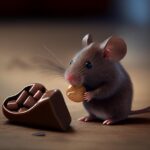Introduction:
In recent years, there has been a growing interest in sustainable and eco-friendly food options. As a result, innovative chefs and bakers have been experimenting with alternative ingredients to create delicious treats that not only satisfy our taste buds but also contribute positively to the environment. One such creation is the chocolate chirp cookie – a delightful twist on the classic cookie recipe that incorporates cricket flour, offering a sustainable protein source without compromising on flavor. Let’s explore the intriguing world of chocolate chirp cookies and why they’re becoming a popular choice for eco-conscious foodies everywhere.

1. The Rise of Insect-Based Foods: – Sustainable Protein: Insects, such as crickets, have gained attention for their sustainability compared to traditional livestock farming. They require significantly less water, land, and feed to produce the same amount of protein. – Nutritional Benefits: Cricket flour is rich in protein, vitamins, and minerals, making it a nutritious addition to baked goods. – Environmental Impact: Incorporating insect-based ingredients reduces greenhouse gas emissions and minimizes ecological footprint, aligning with the goals of sustainable food production.
2. Crafting the Perfect Chocolate Chirp Cookie Recipe: – Balancing Flavors: Chocolate chirp cookies combine the rich, indulgent taste of chocolate with the nutty, earthy flavor of cricket flour. The balance of sweetness and depth of flavor creates a uniquely satisfying treat. – Texture: Cricket flour adds a subtle crunch to the cookies, enhancing their texture and providing a delightful contrast to the softness of the chocolate chips. – Ingredient Substitutions: Traditional cookie ingredients such as flour and eggs can be partially replaced with cricket flour and alternative binders like flaxseed or applesauce to accommodate dietary preferences and restrictions.
3. Overcoming the “Yuck” Factor: – Cultural Perception: In many Western societies, the idea of consuming insects may initially elicit a negative response due to cultural biases and perceptions. – Education and Awareness: Promoting the nutritional and environmental benefits of insect-based foods can help shift perceptions and encourage acceptance among consumers. – Taste Testing: Offering samples of chocolate chirp cookies allows individuals to experience the delicious flavor firsthand, overcoming any hesitations they may have about insect ingredients.
4. Environmental Impact and Sustainability: – Reducing Food Waste: Insects can be raised on organic waste, contributing to the reduction of food waste in landfills. – Lower Resource Consumption: Compared to traditional livestock farming, insect farming requires less water, land, and feed, making it a more sustainable protein source. – Circular Economy: Incorporating insect-based ingredients creates a more circular food system by utilizing by-products and promoting resource efficiency.
5. Embracing Innovation in Food Production: – Culinary Creativity: Chefs and bakers are embracing innovation by experimenting with alternative ingredients like cricket flour to create delicious and sustainable dishes. – Consumer Demand: With an increasing focus on sustainability and ethical consumption, there is a growing demand for eco-friendly food options, driving the popularity of insect-based foods. – Collaborative Efforts: Collaboration between food scientists, farmers, and chefs is essential for advancing the development of insect-based products and integrating them into mainstream culinary culture.
Conclusion:
Chocolate chirp cookies represent more than just a tasty treat; they embody a shift towards sustainable and eco-conscious food choices. By embracing innovative ingredients like cricket flour, we can enjoy delicious desserts while reducing our environmental impact and promoting a more sustainable food system. So, the next time you’re craving something sweet, consider indulging in a chocolate chirp cookie – not only will your taste buds thank you, but so will the planet.










